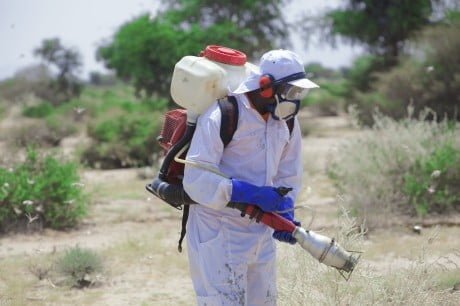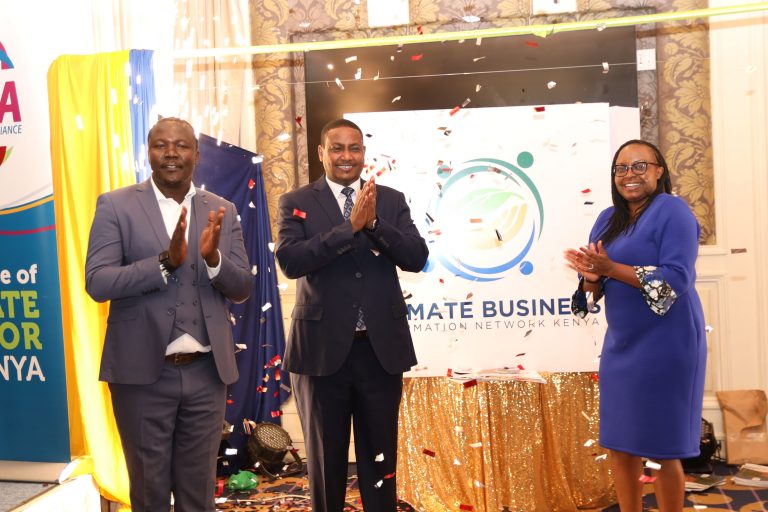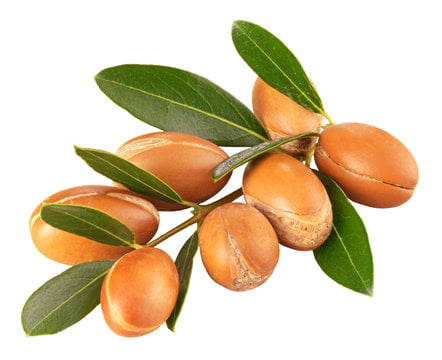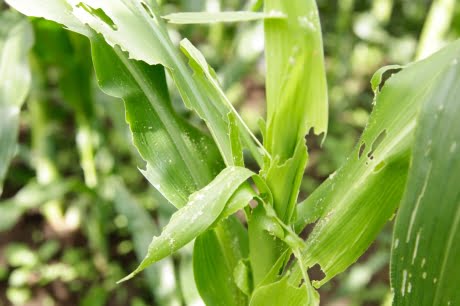The first wave of desert locust swarms hit Somalia in 2019. Carpets of hopper bands and clouds of locust swarms resembling those of a storm started appearing throughout the country. As the locusts descended on any vegetation they could find, crops succumbed to their appetite; fields became barren with nothing left behind for animals to graze and the livelihoods of agropastoralists and smallholder farmers were shattered in a matter of hours.
For decades, chemical pesticides have been the only solution to controlling desert locust numbers. Though chemical pesticides are highly effective at controlling locusts, they can impact more than just these pests, creating environmental and human health risks. In recent years, the development of nature-based biopesticides has offered a safer alternative to locust control.
During this 2019-2022 desert locust crisis, the Government of Somalia, together with FAO, used biopesticides and Insect Growth Regulators (IGRs) exclusively to control these pests, achieving a first in this kind of response and setting an example for locust management worldwide.
Biopesticides use natural bacteria, fungi or viruses to attack insect pests. One fungus, Metarhizium acridum, used in Somalia has proven to be particularly effective in controlling locusts by feeding on the targeted insect, killing them in a week or two.
IGRs, also used as part of the response, are a more innocuous and targeted chemical remedy. They prevent locusts from moulting from one stage to the next, stopping reproduction and egg-hatching. Because they selectively target insect pests and have low levels of toxicity, these, too, have a much lighter environmental impact than traditional pesticides.
iopesticides have always been the preferred option. However, because they are slow acting, they need to be used alongside other supporting technology. For example, early detection is crucial to leave enough time for the biopesticides to act before the locusts can cause significant damage to the area. FAO has a plethora of technological tools, such as the eLocust3 suite, that harness satellite imagery analysis, employ predictive models and facilitate reporting, making prompt action possible.

“The Government of Somalia received equipment from FAO, notably eLocust3 tablets and eLocust3g GPS modules, for desert locust surveys. Technical staff from the local ministry of the Puntland area performed locust monitoring operations twice a week using the eLocust3 and eLocust3g tools,” explained Abdihamid Salad Hassan, a locust control officer with the Government of Somalia.
In northern Somalia, grazing is critical to the livelihoods of the pastoralist population. But chemical pesticides can mean that sprayed areas become unsuitable for livestock for some time. This is not the case for biopesticides, allowing pastoralists to continue their livelihoods.
Hassan recounts, “Initially, we used traditional chemical pesticides, but they had a high impact on pastoral areas. With FAO’s guidance, the Government chose to use biopesticides to protect these vulnerable areas. After initial testing, chemical pesticide use was stopped.”
The outstanding results achieved by Somalia with FAO’s help are being analysed and shared between locust-affected countries. Since the crisis ended, FAO has organised several trainings and workshops with locust officers and ministry officials to improve locust management practices and share results.
One such training in Morocco was carried out by FAO in collaboration with the Commission for Controlling the Desert Locust in the Central Region (CRC), the Commission for Controlling the Desert Locust in the Western Region (CLCPRO) and the Near East Plant Protection Organization (NEPPO). This training specifically aimed to enhance the use of biopesticides in the affected countries.
These trainings also helped advocate for the national registration of biopesticides, a necessary first step in using these types of compounds in a response operation. “I presented in Agadir the results achieved with biopesticides, helping to develop strategic platforms for the African countries affected by desert locusts and to share experiences,” Hassan explains, recalling his experience at the training of showcasing Somalia’s great success.
Several experts from locust-prone countries had an opportunity to learn from the first-hand experience of several FAO and country experts. Such events are vital to promoting best practices and developing recommendations for the future to continue reducing the global threat posed by locusts.
Though the desert locust situation in the Great Horn of Africa and Yemen is now calm, with no significant outbreaks expected in the coming months, the region continues to contend with unprecedented levels of drought, rising food prices, conflict and COVID-19 knock-on effects. In September 2022, a famine was projected for the upcoming months in Somalia. Had desert locusts been added to the mix, the situation would have been that much worse.
The recent locust crisis also led to the improvement and widespread adoption of monitoring technologies, helping to create an active environment for locust prevention.
“The survey and monitoring programmes are still ongoing in Somalia,” confirmed Hassan.
While this desert locust crisis has passed, FAO is still working with countries to further promote preventative measures. Using satellite mapping, predictive models, tailor-made applications and drones, FAO provides reports and early warnings to countries to prevent future locust outbreaks.
“The adoption of new technologies and alternatives to conventional chemical pesticides is shifting how the world manages locusts. FAO’s goal is to promote the best solutions on a case-by-case basis, providing experience, technology and proven solutions to reduce the damage caused by locusts globally,” says Shoki Al-Dobai, FAO Senior Agricultural Officer.
Hassan concludes, “Biopesticides will continue to be the preferred method for treating locusts in Somalia.”
The most recent outbreak has proven how desert locust control technologies have come a long way to helping reduce and control new crises in the future, while better protecting the environment.






